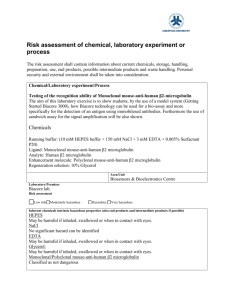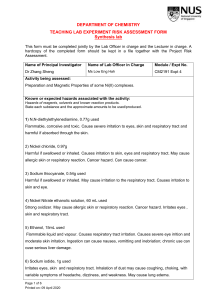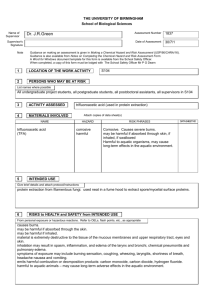Incucyte
advertisement
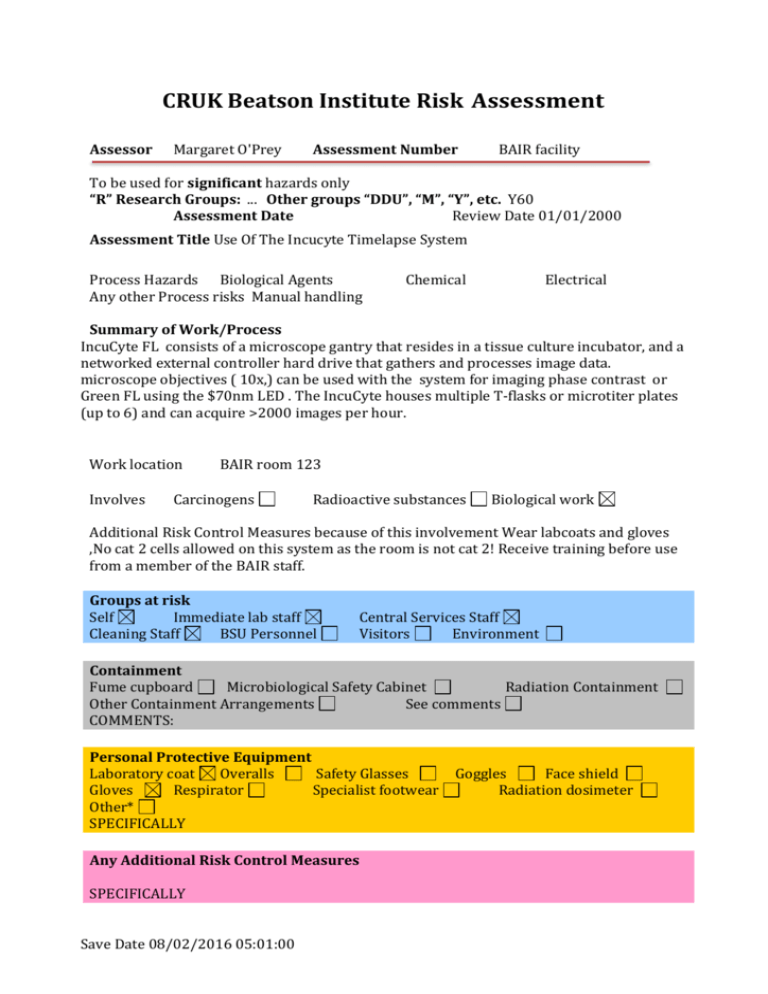
CRUK Beatson Institute Risk Assessment Assessor Margaret O'Prey Assessment Number BAIR facility To be used for significant hazards only “R” Research Groups: ... Other groups “DDU”, “M”, “Y”, etc. Y60 Assessment Date Review Date 01/01/2000 Assessment Title Use Of The Incucyte Timelapse System Process Hazards Biological Agents Any other Process risks Manual handling Chemical Electrical Summary of Work/Process IncuCyte FL consists of a microscope gantry that resides in a tissue culture incubator, and a networked external controller hard drive that gathers and processes image data. microscope objectives ( 10x,) can be used with the system for imaging phase contrast or Green FL using the $70nm LED . The IncuCyte houses multiple T-flasks or microtiter plates (up to 6) and can acquire >2000 images per hour. Work location Involves BAIR room 123 Carcinogens Radioactive substances Biological work Additional Risk Control Measures because of this involvement Wear labcoats and gloves ,No cat 2 cells allowed on this system as the room is not cat 2! Receive training before use from a member of the BAIR staff. Groups at risk Self Immediate lab staff Cleaning Staff BSU Personnel Central Services Staff Visitors Environment Containment Fume cupboard Microbiological Safety Cabinet Radiation Containment Other Containment Arrangements See comments COMMENTS: Personal Protective Equipment Laboratory coat Overalls Safety Glasses Gloves Respirator Specialist footwear Other* SPECIFICALLY Any Additional Risk Control Measures SPECIFICALLY Save Date 08/02/2016 05:01:00 Goggles Face shield Radiation dosimeter e.g. any required checks on control measures and their frequency; health surveillance, etc., Health Surveillance choose Substances involved Substance 1 Live TC cells that the user will bring down to the incubator. Possible chemicals and drugs on the cells. The individual user should already have a procedure for working with there cells and the chemicals that they are using.They should know if there is any limitation of safety precautions that need to be taken for their samples. COSHH code 0 Frequency of use select Exposure time Select Exposure Limit Route of hazardous exposure Select route Hazard “H” codes (to complete with correct code CLICK HERE to skip to bottom of page and copy & paste) Handling of substance labcoats, gloves Substance 2 ethanol COSHH code 1 Frequency of use select Exposure time Select Exposure Limit Route of hazardous exposure Select route Hazard “H” codes (to complete with correct code CLICK HERE and copy & paste) H302 + H312 + H332 Harmful if swallowed, in contact with skin or if inhaled H226 Flammable liquid and vapour H316 Causes mild skin irritation H320 Causes eye irritation H335 May cause respiratory irritation Handling of substance Substance 3 COSHH code 0 Frequency of use select Exposure time Select Exposure Limit Route of hazardous exposure Select route Hazard “H” codes (to complete with correct code CLICK HERE and copy & paste) Handling of substance Substance 4 Save Date 08/02/2016 05:01:00 COSHH code 0 Frequency of use select Exposure time Select Exposure Limit Route of hazardous exposure Select route Hazard “H” codes (to complete with correct code CLICK HERE and copy & paste) Handling of substance More Substances Used! See additional sheet Biological Agents Will be working with: Primary human cells (tissues, blood etc) Samples with a blood borne virus risk Viral vectors (Adenovirus, Lentivirus, Retrovirus) Will need to use sharps with above biological agents Spillage / uncontrolled release Specify the procedure for containing a spillage / release of chemicals or intermediates. wipe any spillage with 70% etoh Equipment Identify equipment Incucyte FL and incubator used All the equipment required for this process has been checked for safe operation prior to use. YES NO Relevant safety locks are working and in place YES NO Risk reduction measures Comments hereUser needs to be trained by a member of the BAIR staff. Fire Precautions Specify the appropriate firefighting equipment required. Not Applicable CO2 (Black) Foam (Cream) Water (Red) Dry Powder (Blue) Fire Blanket Sand Other* *Specify Comments here First Aid Note: this form should be taken with injured person(s) where medical attention is required. Specify first aid treatment or any special antidotes… Eyes: Irrigate thoroughly with water for 15 mins Comments Skin: Irrigate thoroughly with water for 15 mins Comments Comments Mouth (Ingestion): Seek medical assistance Comments Mouth (inhalation): Seek medical assistance Comments Further details: Comments Save Date 08/02/2016 05:01:00 Radiation please note: the special risk assessment (see intranet.) is required for radiation work with unsealed sources. Radiation type Choose *Other add info if required Radionuclide to be used Choose Activity MBq Chemical Form Monitor used Choose Frequency of use select Duration of use Select Disposal of radioactive waste Radioactive Waste as a % Solid / Liquid as determined by Scintillation count 9% Solid 91% liquid Disposal of Waste COSHH 3 chemicals and tips into Blue topped sharps bins Specify Chemical Waste No1 Storage arrangements prior to disposal 1 No2 2 No.3 3 Disposal arrangements Chemical destruction / Neutralisation related COSHH risk assessment Disposal via contractor other details Degree of Supervision Work carried out by User after training by BAIR staff A Work may not be carried out without direct personal supervision by: Level of supervision required A Signed by user: Signed by user: Signed by user: Signed by user: B Work may not be started without the advice and approval of A member of BAIR staff after training. C Work (other than categories A&B) where it is considered by the project supervisor that the individual is adequately trained & competent in the procedures involved ASSESSMENT APPROVED by: Date Approved: Save Date 08/02/2016 05:01:00 Select one or more “H” (Hazard Codes) to enter in “Substance Hazard boxes” on form Click here to return to “Substances” once you have copied text Combinations H300 + H310 Fatal if swallowed or in contact with skin H300 + H330 Fatal if swallowed or if inhaled H310 + H330 Fatal in contact with skin or if inhaled H300 + H310 + H330 Fatal if swallowed, in contact with skin or if inhaled H301 + H311 Toxic if swallowed or in contact with skin H301 + H331 Toxic if swallowed or if inhaled H311 + H331 Toxic in contact with skin or if inhaled H301 + H311 + H331 Toxic if swallowed, in contact with skin or if inhaled H302 + H312 Harmful if swallowed or in contact with skin H302 + H332 Harmful if swallowed or if inhaled H312 + H332 Harmful in contact with skin or if inhaled H302 + H312 + H332 Harmful if swallowed, in contact with skin or if inhaled H303 + H313 May be harmful if swallowed or in contact with skin H303 + H333 May be harmful if swallowed or if inhaled H313 + H333 May be harmful in contact with skin or if inhaled H303 + H313 + H333 May be harmful if swallowed, in contact with skin or if inhaled H315 + H320 Causes skin and eye irritation Individual phrases H200 Unstable explosive H201 Explosive; mass explosion hazard H202 Explosive; severe projection hazard H203 Explosive; fire, blast or projection hazard H204 Fire or projection hazard H205 May mass explode in fire H220 Extremely flammable gas H221 Flammable gas H222 Extremely flammable aerosol H223 Flammable aerosol H224 Extremely flammable liquid and vapour H225 Highly flammable liquid and vapour H226 Flammable liquid and vapour H227 Combustible liquid H228 Flammable solid H240 Heating may cause an explosion H241 Heating may cause a fire or explosion H242 Heating may cause a fire H250 Catches fire spontaneously if exposed to air H251 Self-heating; may catch fire Save Date 08/02/2016 05:01:00 H252 Self-heating in large quantities H260 In contact with water releases flammable gases which may ignite spontaneously H261 In contact with water releases flammable gas H270 May cause or intensify fire; oxidizer H271 May cause fire or explosion; strong oxidizer H272 May intensify fire; oxidizer H280 Contains gas under pressure; may explode if heated H281 Contains refrigerated gas; may cause cryogenic burns or injury H290 May be corrosive to metals H300 Fatal if swallowed H301 Toxic if swallowed H302 Harmful if swallowed H303 May be harmful if swallowed H304 May be fatal if swallowed and enters airways H305 May be harmful if swallowed and enters airways H310 Fatal in contact with skin H311 Toxic in contact with skin H312 Harmful in contact with skin H313 May be harmful in contact with skin H314 Causes severe skin burns and eye damage H315 Causes skin irritation H316 Causes mild skin irritation H317 May cause an allergic skin reaction H318 Causes serious eye damage H319 Causes serious eye irritation H320 Causes eye irritation H330 Fatal if inhaled H331 Toxic if inhaled H332 Harmful if inhaled H333 May be harmful if inhaled H334 May cause allergy or asthma symptoms or breathing difficulties if inhaled H335 May cause respiratory irritation H336 May cause drowsiness or dizziness H340 May cause genetic defects H341 Suspected of causing genetic defects H350 May cause cancer H351 Suspected of causing cancer H360 May damage fertility or the unborn child H361 Suspected of damaging fertility or the unborn child H362 May cause harm to breast-fed children H370 Causes damage to organs H371 May cause damage to organs H372 Causes damage to organs through prolonged or repeated exposure H373 May cause damage to organs through prolonged or repeated exposure H400 Very toxic to aquatic life H401 Toxic to aquatic life H402 Harmful to aquatic life H410 Very toxic to aquatic life with long lasting effects H411 Toxic to aquatic life with long lasting effects Save Date 08/02/2016 05:01:00 H412 Harmful to aquatic life with long lasting effects H413 May cause long lasting harmful effects to aquatic life H420 Harms public health & environment by destroying ozone in upper atmosphere Save Date 08/02/2016 05:01:00
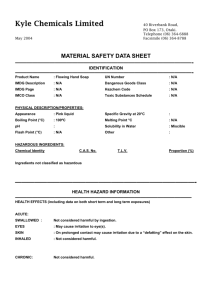
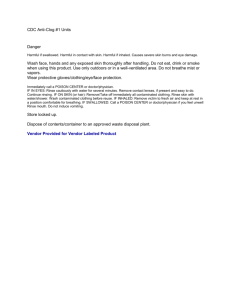
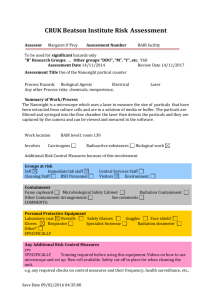
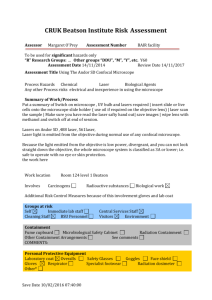
![[Download MSDS] (.doc)](http://s3.studylib.net/store/data/006712111_1-6d2aee48fdad537db5a64f921a9ed630-300x300.png)

